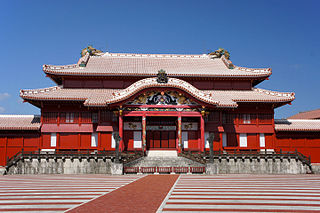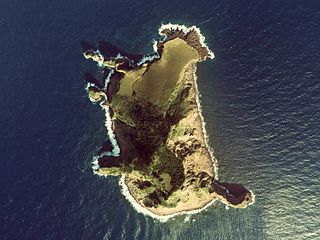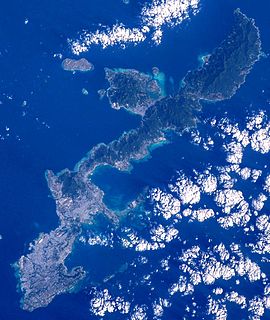 W
WThe Ryukyu Islands , also known as the Nansei Islands or the Ryukyu Arc , are a chain of Japanese islands that stretch southwest from Kyushu to Taiwan: the Ōsumi, Tokara, Amami, Okinawa, and Sakishima Islands, with Yonaguni the westernmost. The larger are mostly high islands and the smaller mostly coral. The largest is Okinawa Island.
 W
WIn the Battle of Okinawa, Cactus Ridge was the name U.S. forces gave to a rise of land approximately 600 yards (550 m) southeast of Mashiki, Okinawa which commanded much of the ground between Uchitomari and Oyama, both of which lie along Highway No. 1. The defense of Cactus Ridge to the west, and The Pinnacle to the east, marked the start of resistance by Japanese land forces on Okinawa.
 W
WChūzan (中山) was one of three kingdoms which controlled Okinawa in the 14th century. Okinawa, previously controlled by a number of local chieftains or lords, loosely bound by a paramount chieftain or king of the entire island, split into these three more solidly defined kingdoms within a few years after 1314; the Sanzan period thus began, and would end roughly one hundred years later, when Chūzan's King Shō Hashi conquered Hokuzan in 1419 and Nanzan in 1429.
 W
WThe Daitō Islands are an archipelago consisting of three isolated coral islands in the Philippine Sea southeast of Okinawa. The islands have a total area of 44.427 square kilometres (17.153 sq mi) and a population of 2,107.
 W
WFar East Command (FECOM) was a unified combatant command of the United States Department of Defense, active from 1947 until 1957, functionally organised to undertake the occupation of Japan. It was created on 1 January 1947, and abolished, with functions transferred to Pacific Command, effective 1 July 1957. From 1947–51 the Commander-in-Chief, Far East (CINCFE), was General Douglas MacArthur, who was then succeeded by Generals Matthew Ridgway and Mark Clark. Later commanders were Generals John E. Hull, Maxwell D. Taylor, and finally Lyman Lemnitzer.
 W
WThis article is about the history of the Ryukyu Islands southwest of the main islands of Japan.
 W
WIheya Island is an island located in the Okinawa Islands of Okinawa Prefecture, Japan.
 W
WIzena Island is located in the East China Sea, north-west of Okinawa Island, in the Ryukyu Islands of Japan. The island has a diameter of about 5 kilometres (3.1 mi) and is surrounded by coral reefs, blue sea, and white beaches. It is administered as Izena Village. The five settlements of about equal size and population which are located on the island are Izena, Nakada, Shomi, Uchihana, and Jicchaku.
 W
WThe Japanese punitive expedition to Taiwan in 1874, referred to in Japan as the Taiwan Expedition and in Taiwan and China as the Mudan incident, was a punitive expedition launched by the Japanese in retaliation for the murder of 54 Ryukyuan sailors by Paiwan aborigines near the southwestern tip of Taiwan in December 1871. The success of the expedition, which marked the first overseas deployment of the Imperial Japanese Army and Imperial Japanese Navy, revealed the fragility of the Qing dynasty's hold on Taiwan and encouraged further Japanese adventurism. Diplomatically, Japan's embroilment with China in 1874 was eventually resolved by a British arbitration under which Qing China agreed to compensate Japan for property damage. Some ambiguous wording in the agreed terms were later argued by Japan to be confirmation of Chinese renunciation of suzerainty over the Ryukyu Islands, paving the way for de facto Japanese incorporation of Ryukyu in 1879.
 W
WKadena Air Base is a United States Air Force base in the towns of Kadena and Chatan and the city of Okinawa, in Okinawa Prefecture, Japan. It is often referred to as the "Keystone of the Pacific". Kadena Air Base is home to the USAF's 18th Wing, the 353d Special Operations Group, reconnaissance units, 1st Battalion, 1st Air Defense Artillery, and a variety of associated units. Over 20,000 American servicemembers, family members, and Japanese employees live or work aboard Kadena Air Base. It is the largest and most active US Air Force base in the Far East.
 W
WKaminonejima or Kaminone Island, is a small uninhabited island located in the Tokara Islands of Kagoshima Prefecture, Japan.
 W
WKayama Island is a small uninhabited island located in the Yaeyama Islands of Okinawa Prefecture, Japan. It situated 2 kilometers northeast of Kohama Island.
 W
WThe Ryukyu Kingdom was a kingdom in the Ryukyu Islands from 1429 to 1879.
 W
WThe Miyako Strait , also known as the Kerama Gap, is a waterway which lies between Miyako Island and Okinawa Island consisting of an approx. 250km wide passageway with international waters and airspace. It is the widest strait in the Ryukyu Islands.
 W
WThe Mudan incident of 1871 was the massacre of 54 Ryūkyūan sailors in Qing-era Taiwan who wandered into the central part of Taiwan after their ship was shipwrecked.
 W
WNanzan (南山), sometimes called Sannan (山南), was one of three kingdoms which controlled Okinawa in the 14th century. Okinawa, previously controlled by a number of local chieftains or lords, loosely bound by a paramount chieftain or king of the entire island, split into these three more solidly defined kingdoms within a few years after 1314; the Sanzan period thus began, and would end roughly one hundred years later, when Chūzan's King Shō Hashi conquered Hokuzan in 1419 and Nanzan in 1429.
 W
WOgoe are posthumous Okinawan portraits. Although it is unknown when the tradition of portraiture first began in the area, Ryukyu developed a unique style during the 15th-19th centuries.
 W
WOkinawa Island is the largest of the Okinawa Islands and the Ryukyu (Nansei) Islands of Japan in the Kyushu region. It is the smallest and least populated of the five main islands of Japan. The island is approximately 106 kilometres (66 mi) long, an average 11 kilometres (7 mi) wide, and has an area of 1,206.98 square kilometers (466.02 sq mi). It is roughly 640 kilometres (400 mi) south of the main island of Kyushu and the rest of Japan. It is 500 km (300 mi) north of Taiwan. The total population of Okinawa Island is 1,384,762. The Greater Naha area has roughly 800,000 residents, while the city itself has about 320,000 people. Naha is the seat of Okinawa Prefecture on the southwestern part of Okinawa Island. Okinawa has a humid subtropical climate.
 W
WOkinawa Prefecture is a prefecture of Japan located on the Ryukyu Islands. Okinawa Prefecture has a population of 1,457,162 and has a geographic area of 2,280 km².
 W
WThe Ryukyu Domain was a short-lived domain of Japan, lasting from 1872 to 1879, before becoming the current Okinawa Prefecture and other islands at the Pacific edge of the East China Sea.
 W
WThe Ryukyuan languages , also Lewchewan languages, are the indigenous languages of the Ryukyu Islands, the southernmost part of the Japanese archipelago. Along with the Japanese language, they make up the Japonic language family. The languages are not mutually intelligible with each other. It is not known how many speakers of these languages remain, but language shift towards the use of Standard Japanese and dialects like Okinawan Japanese has resulted in these languages becoming endangered; UNESCO labels four of the languages "definitely endangered" and two others "severely endangered".
 W
WThe Ryukyuan people , also Lewchewan or Loochooan, are an East Asian ethnic group native to the Ryukyu Islands between the islands of Kyushu and Taiwan. Politically, they live in either Okinawa Prefecture or Kagoshima Prefecture. Their languages make up the Ryukyuan languages, considered to be one of the two branches of the Japonic language family, the other being Japanese and its dialects. Hachijō is sometimes considered to be the third branch.
 W
WThe Sakishima Islands are an archipelago located at the southernmost end of the Japanese Archipelago. They are part of the Ryukyu Islands and include the Miyako Islands and the Yaeyama Islands. The islands are administered as part of Okinawa Prefecture, Japan.
 W
WThe Satsunan Islands is a geopolitical name for a group of islands that forms the northern part of the Ryukyu Islands. The whole island group belongs to Kagoshima Prefecture, Japan.
 W
WSefa-utaki , meaning "purified place of Utaki," is a historical sacred space, overlooking Kudaka Island, that served as one of the key locations of worship in the native religion of the Ryukyuan people for millennia. Later as a part of assimilation of Okinawa by Japan, it was shifted to serve as a Shinto Shrine. It is part of the UNESCO World Heritage Site Gusuku Sites and Related Properties of the Kingdom of Ryukyu in Nanjō, Okinawa.
 W
WSesoko Island is a small island in Okinawa Prefecture, Japan. Politically, the place is administered by the town of Motobu, which is a part of the Kunigami District in the northern Okinawa Islands.
 W
WThe Shimazu clan were the daimyō of the Satsuma han, which spread over Satsuma, Ōsumi and Hyūga provinces in Japan.
 W
WShimazu Tadatsune was a tozama daimyō of Satsuma, the first to hold it as a formal fief (han) under the Tokugawa shogunate, and the first Japanese to rule over the Ryūkyū Kingdom. As lord of Satsuma, he was among the most powerful lords in Japan at the time, and formally submitted to Tokugawa Ieyasu in 1602, to prove his loyalty, being rewarded as a result with the name Matsudaira Iehisa; Matsudaira being a branch family of the Tokugawa, and "Ie" of "Iehisa" being taken from "Ieyasu", this was a great honor. As of 1603, his holdings amounted to 605,000 koku.
 W
WShiraho Saonetabaru Cave Ruins is a paleoanthropological site located on Ishigaki Island of the Yaeyama Islands in Japan. Shiraho Saonetabaru is a limestone cave.
 W
WUnited States nuclear weapons were stored secretly at bases throughout Japan following World War II. Secret agreements between the two governments allowed nuclear weapons to remain in Japan until 1972, to move through Japanese territory, and for the return of the weapons in time of emergency.
 W
WUtaki (御嶽) is an Okinawan term for a sacred place, often a grove, cave, or mountain. They are central to the Ryukyuan religion and the former noro priestess system. Although the term utaki is used throughout the Ryukyu Islands, the terms suku and on are heard in the Miyako and Yaeyama regions respectively. Utaki are usually located on the outskirts of villages and are places for the veneration of gods and ancestors. Most gusuku have places of worship, and it is theorized that the origins of both gusuku and utaki are closely related.
 W
WYabiji is the largest coral reef group in Japan, containing over 100 coral reefs and spanning about 17 by 6.5 km. Known for being above water level several times a year, most visibly around March 3, it was made a Natural Monument of Japan in 2013 as a place of Scenic Beauty. It is located about 6 km off the northern coast of Ikema Island.
 W
WThe Yaeyama Islands are an archipelago in the southwest of Okinawa Prefecture, Japan, and cover 591.46 square kilometres (228.36 sq mi). The islands are located southwest of the Miyako Islands, part of the Ryukyu Islands archipelago. The Yaeyama Islands are the remotest part of Japan from the main islands and contain Japan's most southern (Hateruma) and most western (Yonaguni) inhabited islands. The city of Ishigaki serves as the political, cultural, and economic center of the Yaeyama Islands.